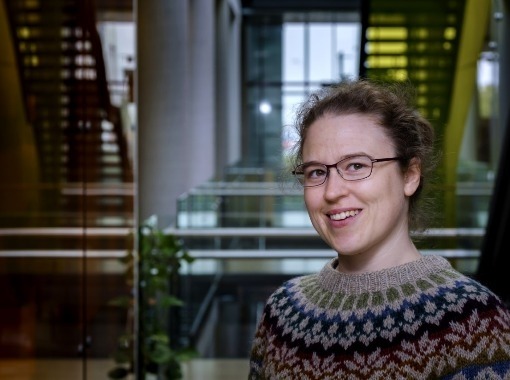Doktoral defence - Bjarnheiður Kristinsdóttir

Aðalbygging
Bjarnheiður Kristinsdóttir defends her PhD thesis in Educational Sciences from the Faculty of subject teacher education, University of Iceland:
Silent video tasks – their definition, development and implementation in upper secondary school mathematics classrooms
The oral defence takes place Tuesday, October 19th, at 11 am in the Aula in the main building of the University of Iceland.
Opponents are Dr Morten Misfeldt professor at Copenhagen University and Dr Merrilyn Goos professor at the University of the Sunshine Coast, Australia.
Main supervisor was Dr Freyja Hreinsdóttir professor at the School of Education, University of Iceland, and co-supervisor Dr Zsolt Lavicza professor at the Linz School of Education at Johannes Kepler University, Austria.
Experts in the doctoral committee were Dr Gunnar Stefánsson professor at the School of Engineering and Natural Sciences, University of Iceland, and Dr Peter Liljedahl professor at Simon Fraser University, Canada.
Dr Elsa Eiríksdóttir Vice Head of Faculty of Subject Teacher Education will conduct the ceremony.
About the PhD project:
The aims of this design-based research project were: i) to gain insight into teachers’ expectations and experiences of using silent video tasks in their mathematics classrooms, ii) to define characteristics of silent videos, iii) to develop (in collaboration with teachers) and describe the process of assigning a silent video task, and iv) to identify opportunities and challenges that silent video tasks bring to the mathematics classroom. For the purpose of task design, the researcher worked with seven teachers in six Icelandic upper secondary schools who implemented silent video tasks in their classrooms.
In short, silent video tasks involve the presentation of a short silent mathematics video clip that students are asked to discuss in pairs as they prepare and record their voice-over to the video. Based on students' recorded responses to the task, that are listened to by the whole group, the teacher leads a discussion with the aim to deepen and widen students' understanding of the mathematical topic presented in the video.
The idea of silent video tasks is grounded in social constructivist theories. It is considered important that interaction happens between teacher and learners and among learners themselves, who work together (support each other) toward richer understanding of mathematical content. The learner is seen as an active participant in the teaching and learning process and in the case of silent video tasks, learners get an opportunity to become aware of their own and their peers' current ways of describing or explaining mathematical phenomena.
Two implementation phases were conducted in 2017 and 2019, during which interview data on teachers' expectations and experiences of using silent video tasks was collected and analysed. In the first phase, four mathematics teachers in randomly selected upper secondary schools in Iceland assigned a silent video task to their 17-year-old students. Results from the first phase indicated that silent video tasks might be a helpful tool for formative assessment.
Thus, teachers in the second phase were purposefully selected to work at schools that aim for active use of formative assessment. One teacher assigned three silent video tasks to his 16-year-old students and two teachers assigned one silent video task to their 16-year-old students. Besides interview data, classroom observation protocols were collected during the second phase.
Data was analysed using theory and empirical results regarding teacher noticing, mathematical and socio-mathematical norms and under influence of building thinking classrooms and teaching for robust understanding. The process of assigning a silent video task developed throughout the project. To conclude, some characteristics that make a video suitable for use in silent video tasks were defined and the instructional sequence of silent video tasks was described. Together with the underlying theoretical and empirical arguments, they form design principles for silent video tasks.
Three papers and one book chapter lay the foundation for this work. The first paper reports on teachers’ expectations and experiences of using silent video tasks, the second paper focuses on what teachers noticed when listening to students’ responses to the tasks, the third paper explains why and how silent video tasks could be used for formative assessment, and the book chapter identifies some opportunities and challenges that arise from the use of silent video tasks.
About the PhD candidate:
Bjarnheiður Kristinsdóttir finished her undergraduate studies in mathematics at the University of Iceland in 2006, a masters degree in applied mathematics at the Technical University of Freiberg in Germany in 2008, and received her mathematics teaching licence for Icelandic upper secondary schools in 2010. Bjarnheiður has worked as a mathematics teacher at the upper secondary school level in Reykjavík and Berlin for 8 years and also has some experience of teaching mathematics and mathematics education at the university level. Since 2016, Bjarnheiður has worked as a doctoral researcher in mathematics education at the University of Iceland and collaborated with the GeoGebra Institute and Linz School of Education at the Johannes Kepler University in Austria. She now works as an adjunct lecturer at the University of Iceland School of Education and participates in a European collaboration project on behalf of the Johannes Kepler University.
Hér vantar að setja inn myndatexta í Uglu



